The Baines slide rule is one of the most unusual ones in my collection, because of the metal contraption on its back that moves all its parts in unison. Here it is:
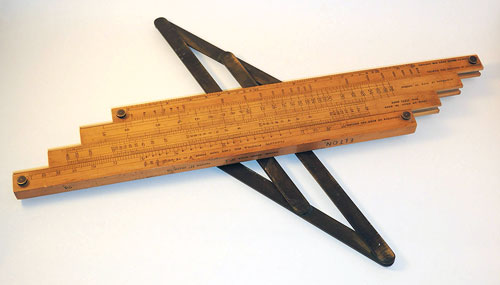
This slide rule was designed by a British civil engineer from the Punjab; it is used to calculate water flows and pressure drops in cast iron water pipes.
You can see the full details, and a sample calculation demonstrating the device’s function, in this new article on my history of computing site.
Clearly marking tool and instrument controls is always a good idea, but it becomes vital where safety is at stake. And if there is one control where safety is definitely at stake, it is the safety catch!
Like this one, on a rechargeable jig saw from Taiwan:
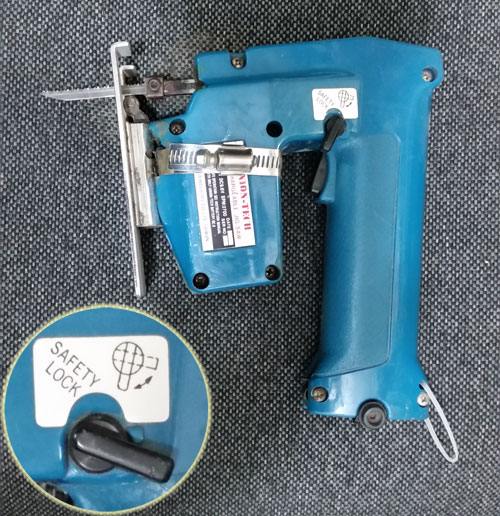
See the switch clearly marked “Safety Lock”? Very informative… but there is not a hint as to which position is the locked one. There is a picture that may try to indicate this, but it is quite ambiguous.
So – this is really a weird implementation of Russian Roulette. But hey, at least it’s rechargeable…
These days the preference for shoddy, cheap, use-and-discard products is all over the place. Here is an example:

This sorry street sign in Jerusalem has taken on a very “artistic” look – because it is made from a blue layer of stick-on plastic sheet over a metal plate. Over time the plastic started to shrink and curl, with this amusing result.
And it occurs to me that the ancients who lived in our city had a better method. Take this stone, which was part of the temple enclosure parapet in the second temple period (around the time of Christ). It too carries a Hebrew inscription, identifying the location of “the house of trumpeting” – the location where the priest stood who blew the ram horn to announce the entry of the Sabbath.
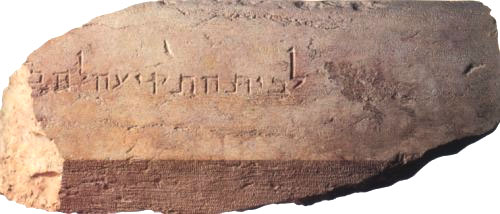
This stone took a big fall when the Romans destroyed the temple, but the lettering on it is crisp and legible after two millennia.
Sigh…
Some of the most fascinating items in my History of Computing collection are the one-of-a-kind, undocumented ones. The latest such addition to the collection is a calculator hidden in a book-like case, that has no mention anywhere that I could find.
This is Charles Cornell’s F.24 aerial photography planning calculator, and you can read all about it in my latest article. Enjoy!
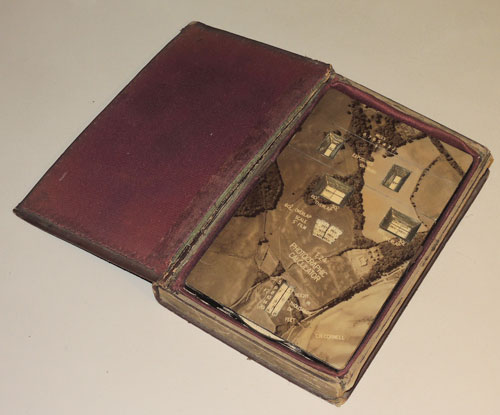
Was on a United flight enjoying my coffee (such as it was), when I noticed the text on the paper cup.
Nice cup:

Makes them feel very ecological, no doubt… someone in Marketing must’ve though it a good point to brag about.
Except that it’s completely meaningless, of course. This statement remains true even if the cup contains zero recycled material.
Sigh…
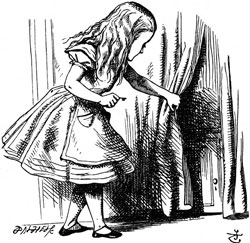 Say “Alice in wonderland”, and the image that comes to mind (well, at least in the generations that used to read books) is a little girl in a tidy Victorian knee-length puffed sleeve dress with a pinafore, and long blond hair – the girl in the image at right. This comes from the famous illustrations by John Tenniel, a successful professional illustrator that Carroll retained to illustrate the book. The illustrations by Tenniel became iconic, although they bear no resemblance to Alice Liddell, the lead character’s namesake, who was not blonde in the least.
Say “Alice in wonderland”, and the image that comes to mind (well, at least in the generations that used to read books) is a little girl in a tidy Victorian knee-length puffed sleeve dress with a pinafore, and long blond hair – the girl in the image at right. This comes from the famous illustrations by John Tenniel, a successful professional illustrator that Carroll retained to illustrate the book. The illustrations by Tenniel became iconic, although they bear no resemblance to Alice Liddell, the lead character’s namesake, who was not blonde in the least.
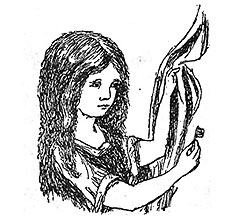 And then there is a different Alice altogether, the one envisioned by Carroll himself and found in the illustrations he drew by his own hand for the handwritten draft of the book, “Alice’s adventures underground”. I have a book showing these, and the comparison is interesting. Here, for example, is the same picture of Alice holding the golden key to the tiny door behind the curtain at the bottom of the rabbit hole. No blond hair, no fancy clothing.
And then there is a different Alice altogether, the one envisioned by Carroll himself and found in the illustrations he drew by his own hand for the handwritten draft of the book, “Alice’s adventures underground”. I have a book showing these, and the comparison is interesting. Here, for example, is the same picture of Alice holding the golden key to the tiny door behind the curtain at the bottom of the rabbit hole. No blond hair, no fancy clothing.
So here, for your enjoyment, are some comparisons of the Carroll and Tenniel realizations of some scenes in the book:
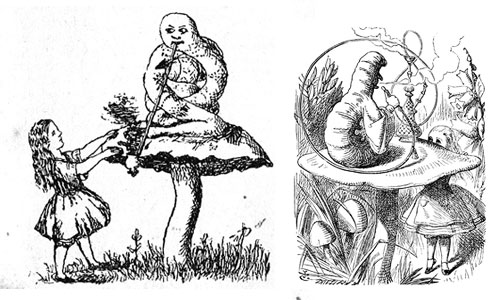
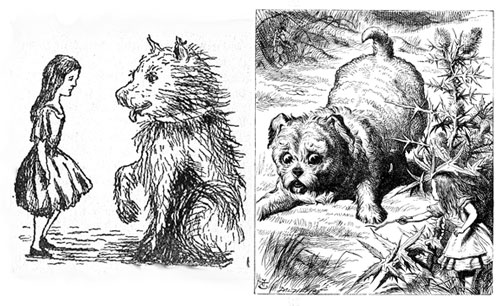
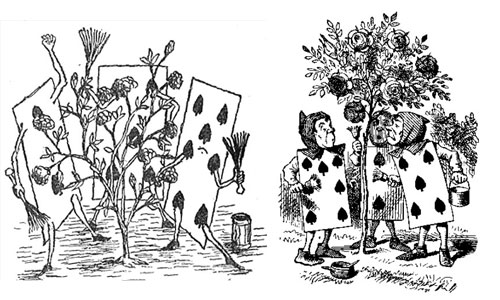
As we can see, Tenniel was definitely a more capable illustrator; but he followed Carroll’s lead — indeed, Carroll supervised him closely, since he was paying him a hefty fee.
And although most of the Tenniel drawings are based on Carroll’s, there are some of the latter that did not make it into the printed book. Like these two:

This Barometer was made in Florence some 100 years ago, and served my late grandfather, first in Italy, then in Israel; it ended up on my wall, a family heirloom to delight the heart of any engineer.
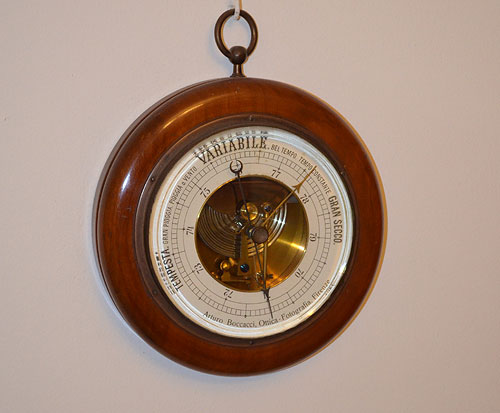
It is a large (23 cm across) Aneroid Barometer, an instrument to measure atmospheric pressure by means of the compression of an evacuated metal capsule (the silvery part with concentric corrugations). Back in the day you would set the golden arrow to cover the black one in the evening, and when leaving home in the morning you’d tap the glass to see which way the black arrow would slightly move from under it – denoting whether the pressure is rising or falling, i.e. whether the weather was getting sunnier or rainier.
What makes this instrument so lovely is the inside mechanism, which is made of springs, hinges, rods and chains that convey the movement to the pointer – and these are made of many beautifully burnished alloys of brass and steel, as you can see below (click either photo to enlarge it).
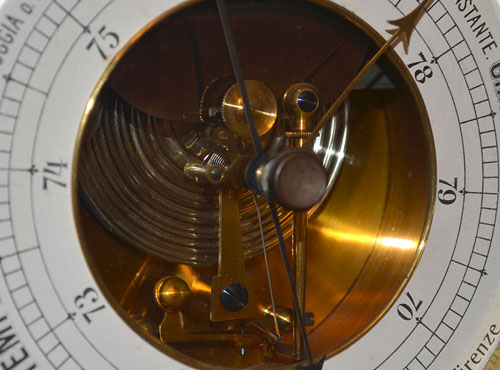
The say some modern smartphones include a barometric sensor… but they can’t hold a candle to my grandpa’s barometer when it comes to sheer elegance and beauty!
I was sitting in the lobby of the Shaare Zedek hospital in Jerusalem, and I noticed on the chair next to me a small booklet someone had discarded there. An idle look turned to admiration as I examined it and realized what it was.

The cover reads “EEG test – the Institute for Neurological Diagnosis“, hardly exciting. But the thing is, obviously, a coloring book. Here are two pages from it:

“Today they examine my head. And I know this does not hurt“.

“In the room there are: A bed and pillow / A working table / And a large apparatus“.
Get the idea? The booklet explains everything clearly, dispelling the strangeness of the intimidating examination room, and of course mitigates the child’s fear; all in a coloring book that takes its mind off the scary goings on ahead.
The last page gives us the names of the good people who developed this wonder and gave it to the hospital. Well done!

New on my Possibly Interesting web site: Cloning a Vibroplex bug, where I describe the venerable Vibroplex semi-automatic telegraph key – and the improvised clone I made as a young radio amateur.

Enjoy!
Form follows function!
Here is a row of anchors, which I photographed in Greenwich in the UK. You’ll note the one in the foreground has a single fluke (as the pointy ends of an anchor are called). The sign says this anchor is from around 1820.

So why would they produce an anchor with only one fluke, when most of them have two? For a very good reason.
This model was used in permanent ship moorings in shallow waters. Think of the ship floating above the anchor. Think of the falling tide. Think what will happen if the ships comes down too close to an upward-pointing fluke…
That’s why!






 Say “Alice in wonderland”, and the image that comes to mind (well, at least in the generations that used to read books) is a little girl in a tidy Victorian knee-length puffed sleeve dress with a pinafore, and long blond hair – the girl in the image at right. This comes from the famous illustrations by John Tenniel, a successful professional illustrator that Carroll retained to illustrate the book. The illustrations by Tenniel became iconic, although they bear no resemblance to
Say “Alice in wonderland”, and the image that comes to mind (well, at least in the generations that used to read books) is a little girl in a tidy Victorian knee-length puffed sleeve dress with a pinafore, and long blond hair – the girl in the image at right. This comes from the famous illustrations by John Tenniel, a successful professional illustrator that Carroll retained to illustrate the book. The illustrations by Tenniel became iconic, although they bear no resemblance to  And then there is a different Alice altogether, the one envisioned by Carroll himself and found in the illustrations he drew by his own hand for the handwritten draft of the book, “Alice’s adventures underground”. I have a book showing these, and the comparison is interesting. Here, for example, is the same picture of Alice holding the golden key to the tiny door behind the curtain at the bottom of the rabbit hole. No blond hair, no fancy clothing.
And then there is a different Alice altogether, the one envisioned by Carroll himself and found in the illustrations he drew by his own hand for the handwritten draft of the book, “Alice’s adventures underground”. I have a book showing these, and the comparison is interesting. Here, for example, is the same picture of Alice holding the golden key to the tiny door behind the curtain at the bottom of the rabbit hole. No blond hair, no fancy clothing.












